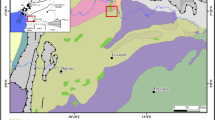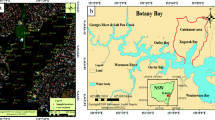Abstract
The environmental impacts of Boroo gold mine project in Mongolia was evaluated by chemical characterization of trace element concentrations in water, soils and tailing dam sediment samples. The results showed that concentrations of B, Cd, Ni and Se in the water samples were within the accepted levels of the Mongolia water quality standard (MNS4586: 1998). However, the concentrations of Al, As, Cu, Mn, Fe, Pb, U and Zn were higher than the maximum allowable concentration especially in the monitoring and heap leach wells. The average concentrations of As, Cd, Cu, Ni, Pb and Zn in the tailing dam sediment were 4419, 58.5, 56.0, 4.8, 20.6 and 25.7 mg/kg, respectively. Generally, arsenic and heavy metals in the soil samples were within the acceptable concentrations of the soil standard of Mongolia (MNS 5850: 2008). The chemical characterization of As solid phase in tailing dam sediment showed that the majority of As were found in the residual fraction comprising about 74% of total As. Assessing the potential risk to humans, simple bioavailability extraction test was used to estimate bioavailability of arsenic and heavy metals, and the concentrations extracted from tailing dam sediment were; 288.2 mg/kg As, 7.2 mg/kg Cd, 41.1 mg/kg Cu, 13.5 mg/kg Pb, 4.7 mg/kg Ni and 23.5 mg/kg Zn, respectively. From these results, the Boroo gold mine project has presently not significantly impacted the environment, but there is a high probability that it may act as a source of future contamination.

Similar content being viewed by others
References
Ahn, J. S., Park, Y. S., Kim, J. Y., & Kim, K. W. (2005). Mineralogical and geochemical characterization of arsenic in an abandoned mine tailings of Korea. Environmental Geochemistry and Health, 27, 147–157.
Borba, R. P., Figueiredo, B. R., & Matschullat, J. (2003). Geochemical distribution of arsenic in waters, sediments and weathered gold mineralized rocks from Iron Quadrangle, Brazil. Environmental Geology, 44, 39–52.
Bose, P., & Sharma, A. (2002). Role of iron in controlling speciation and mobilization of arsenic in subsurface samples. Water Research, 36, 4916–4926.
Bowell, R. J. (1994). Sorption of arsenic by iron oxides and oxyhydroxides in soils. Applied Geochemistry, 9, 279–286.
Bowen, H. J. M. (1979). Environmental chemistry of elements. London: Academic Press.
Bulgan, T. (2008). Chemical analysis of water. Laboratory manual, Central Laboratory of Environment and Meteorology, Ulaanbartar, Mongolia.
Dalai, D., & Dorjbaatar, E. (2008). Environmentally safe tailings storage facility of Boroo gold mine, Mongolia, proceedings of IFOST-2008—3rd international forum on strategic technologies, art. no. 4602892, 623–628.
Devesa-Rey, R., Paradelo, R., Diaz-Fierros, F., & Barral, M. T. (2008). Fractionation and bioavailability of arsenic in the bed sediments of Anllons River (NW Spain). Water Air Soil Pollution, 195, 189–199.
Douay, F., Pruvot, C., Roussel, H., Ciesielski, H., Fourrier, H., Proix, N., et al. (2008). Contamination of urban soils in an area of northern France polluted by dust emissions of two smelters. Water Air Soil Pollution, 188, 247–260.
Espinosa, E., Armienta, M. A., Cruz, O., Aguayo, A., & Ceniceros, N. (2009). Geochemical distribution of arsenic, cadmium, lead and zinc in river sediments affected by tailings in Zimapan, a historical polymetalic mining zone of Mexico. Environmental Geology, 58, 1467–1477.
Fuentes, A., Llorens, M., Saez, J., Soler, A., Aguilar, M. I., Ortuno, J. F., et al. (2004). Simple and sequential extractions of heavy metals from different sewage sludges. Chemosphere, 54, 1039–1047.
Huang, S. S., Liao, Q. L., Hua, M., Wu, X. M., Bi, K. S., Yan, C. Y., et al. (2007). Survey of heavy metal pollution and assessment of agricultural soil in Yangzhong district, Jiangsu Province, China. Chemosphere, 67, 2148–2155.
Jarvas, K. E., Gray, A. L., & Hour, R. S. (Eds.). (1992). Sample preparation for ICP-MS. In: Handbook of inductively coupled plasma mass spectrometry (Chap. 7). Glasgow: Blackie.
Johnston, S. E., & Barnard, W. M. (1979). Comparative effectiveness of fourteen solutions for extracting arsenic from four western New York soils. Soil Science Society American Journal, 43, 304.
Kabata-Pendias, A., & Pendias, H. (1984). Trace elements in soils and plants. Boca Raton: CRC Press.
Keon, N. E., Swartz, C. H., Brabander, D. J., Harvey, C., & Hemond, H. F. (2001). Validation of an arsenic sequential extraction method for evaluating mobility in sediments. Environmental Science Technology, 35, 2778–2784.
Kim, J. Y., Kim, K. W., Ahn, J. S., & Lee, C. H. (2005). Investigation and risk assessment modeling of As and other heavy metals contamination around five abandoned metal mines in Korea. Environmental Geochemistry and Health, 27, 193–203.
Kim, J. Y., Kim, K. W., Lee, J. U., Lee, J. S., & Cook, J. (2002). Assessment of As and heavy metal contamination in the vicinity of Duckum Au-Ag mine, Korea. Environmental Geochemistry and Health, 24, 215–227.
Kim, K. W., Lee, H. K., & Yoo, B. C. (1998). The environmental impact of gold mines in the Yugu-Kwangcheon Au-Ag metallogenic province, Republic of Korea. Environmental Technology, 19, 291–298.
Krysiak, A., & Karczewska, A. (2007). Arsenic extractability in the areas of former arsenic mining and smelting, SW Poland. Science of the Total Environment, 379, 190–200.
Laxen, D. P. H., & Harrison, R. M. (1981). Cleaning methods for polyethene containers prior to the determination of trace metals in freshwater samples. Analytical Chemistry, 53, 345.
Lee, S. W., Lee, B. T., Kim, J. Y., Kim, K. W., & Lee, J. S. (2006). Human risk assessment for heavy metal and As contamination in the abandoned metal mine areas, Korea. Environmental Monitoring and Assessment, 119, 233–244.
Liu, F., De Cristofaro, A., & Violante, A. (2001). Effect of pH, phosphate and oxalate on the adsorption/desorption of arsenate on/from goethite. Soil Science, 166, 197–208.
MNS 4586:1998 Water quality standard, Mongolia.
MNS 4943:2000 Effluent standard, Mongolia.
MNS 900:2005 Environment. Health protection. Safety. Drinking water. Hygienically requirements, assessment of the quality and safety, Mongolia.
MNS 5850:2008 Soil quality. Maximum allowable concentrations of soil pollutants and elements, Mongolia.
O’Neil, P. (1995). Arsenic. In B. J. Alloway (Ed.), Heavy metals in soils (pp. 83–99). Glasgow: Blackie.
Oliveira, A. S., Bocio, A., Trevilato, B. T. M., Takayanagui, A. M. M., Domingo, J. L., & Segura-Munoz, S. I. (2007). Heavy metals in untreated/treated urban effluent and sludge from a biological wastewater treatment plant. Environmental Science and Pollution Research, 14(7), 483–489.
Ramsey, M. H., Thompson, M., & Banerjee, E. K. (1987). Realistic assessment of analytical data quality from inductively coupled plasma atomic emission spectrometry. Analysis Proceedings, 24, 260–265.
Ruiz-Chancho, M. J., Lopez-Sanchez, J. F., & Rubio, R. (2007). Analytical speciation as a tool to assess arsenic behavior in soils polluted by mining. Analytical and Bioanalytical Chemistry, 387, 627–635.
Thalenhorst, H., & Farquharson, P. (2004). Technical report on the Boroo Gold Mine Mongolia for CENTERRA GOLD INC. centerragold.com/media/…/boroo_techreport_may13_final.pdf.
Ure, A. M. (1995). Methods of analysis for heavy metals in soils. In B. J. Alloway (Ed.), Heavy metals in soils (pp. 58–102). Glasgow: Chapman and Hall.
Wenzel, W. W., Kirchbaumer, N., Prohaska, T., Stingeder, G., Lombi, E., & Adriano, D. C. (2001). Arsenic fractionation in soils using an improved sequential extraction procedure. Analytica Chimica Acta, 436, 309–323.
WHO. (2006). Guidelines for drinking water quality (3rd ed.). World Health Organization.
Yellishetty, M., Ranjith, P. G., & Kumar, D. L. (2009). Metal concentrations and metal mobility in unsaturated mine wastes in mining areas of Goa, India, Resources. Conservation & Recycling, 53, 379–385.
Acknowledgments
This study was supported by United Nations University (UNU) and Gwangju Institute of Science and Technology (GIST) Joint Programme on Science and Technology for Sustainability.
Author information
Authors and Affiliations
Corresponding author
Rights and permissions
About this article
Cite this article
Inam, E., Khantotong, S., Kim, KW. et al. Geochemical distribution of trace element concentrations in the vicinity of Boroo gold mine, Selenge Province, Mongolia. Environ Geochem Health 33 (Suppl 1), 57–69 (2011). https://doi.org/10.1007/s10653-010-9347-1
Received:
Accepted:
Published:
Issue Date:
DOI: https://doi.org/10.1007/s10653-010-9347-1




